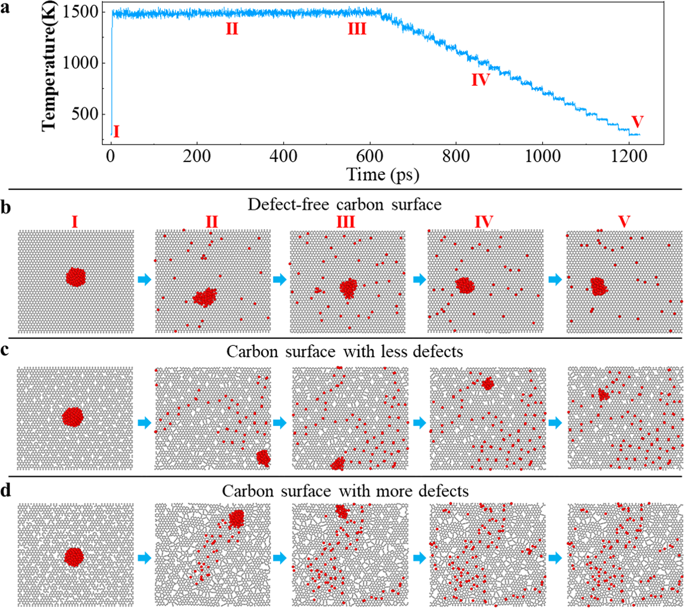npj Computational Materials ( IF 9.4 ) Pub Date : 2020-03-19 , DOI: 10.1038/s41524-020-0292-y Lianping Wu , Shuling Hu , Wenshan Yu , Shengping Shen , Teng Li

|
Single-atom (SA) catalysts represent the ultimate limit of atom use efficiency for catalysis. Promising experimental progress in synthesizing SA catalysts aside, the atomic-scale transformation mechanism from metal nanoparticles (NPs) to metal SAs and the stabilization mechanism of SA catalysts at high temperature remain elusive. Through systematic molecular dynamics simulations, for the first time, we reveal the atomic-scale mechanisms associated with the transformation of a metal NP into an array of stable SAs on a defective carbon surface at a high temperature, using Au as a model material. Simulations reveal the pivotal role of defects in the carbon surface in trapping and stabilizing the Au-SAs at high temperatures, which well explain previous experimental observations. Furthermore, reactive simulations demonstrate that the thermally stable Au-SAs exhibit much better catalyst activity than Au-NPs for the methane oxidation at high temperatures, in which the substantially reduced energy barriers for oxidation reaction steps are the key. Findings in this study offer mechanistic and quantitative guidance for material selection and optimal synthesis conditions to stabilize metal SA catalysts at high temperatures.
中文翻译:

有缺陷的碳表面上单原子催化剂的稳定机理
单原子(SA)催化剂代表了原子用于催化的效率的最终极限。除了合成SA催化剂方面的实验性进展外,从金属纳米颗粒(NPs)到金属SA的原子级转变机理以及SA催化剂在高温下的稳定机理仍然难以捉摸。通过系统的分子动力学模拟,我们首次揭示了使用金作为模型材料,在高温下将金属NP转变为有缺陷的碳表面上的稳定SA阵列的原子级机理。模拟揭示了碳表面缺陷在高温下捕获和稳定Au-SA的关键作用,这很好地解释了先前的实验观察结果。此外,反应模拟表明,对于高温下的甲烷氧化,热稳定的Au-SAs表现出比Au-NPs更好的催化剂活性,其中氧化反应步骤的能垒大大降低是关键。这项研究的发现为材料选择和最佳合成条件提供了机械和定量指导,以稳定高温下的金属SA催化剂。











































 京公网安备 11010802027423号
京公网安备 11010802027423号